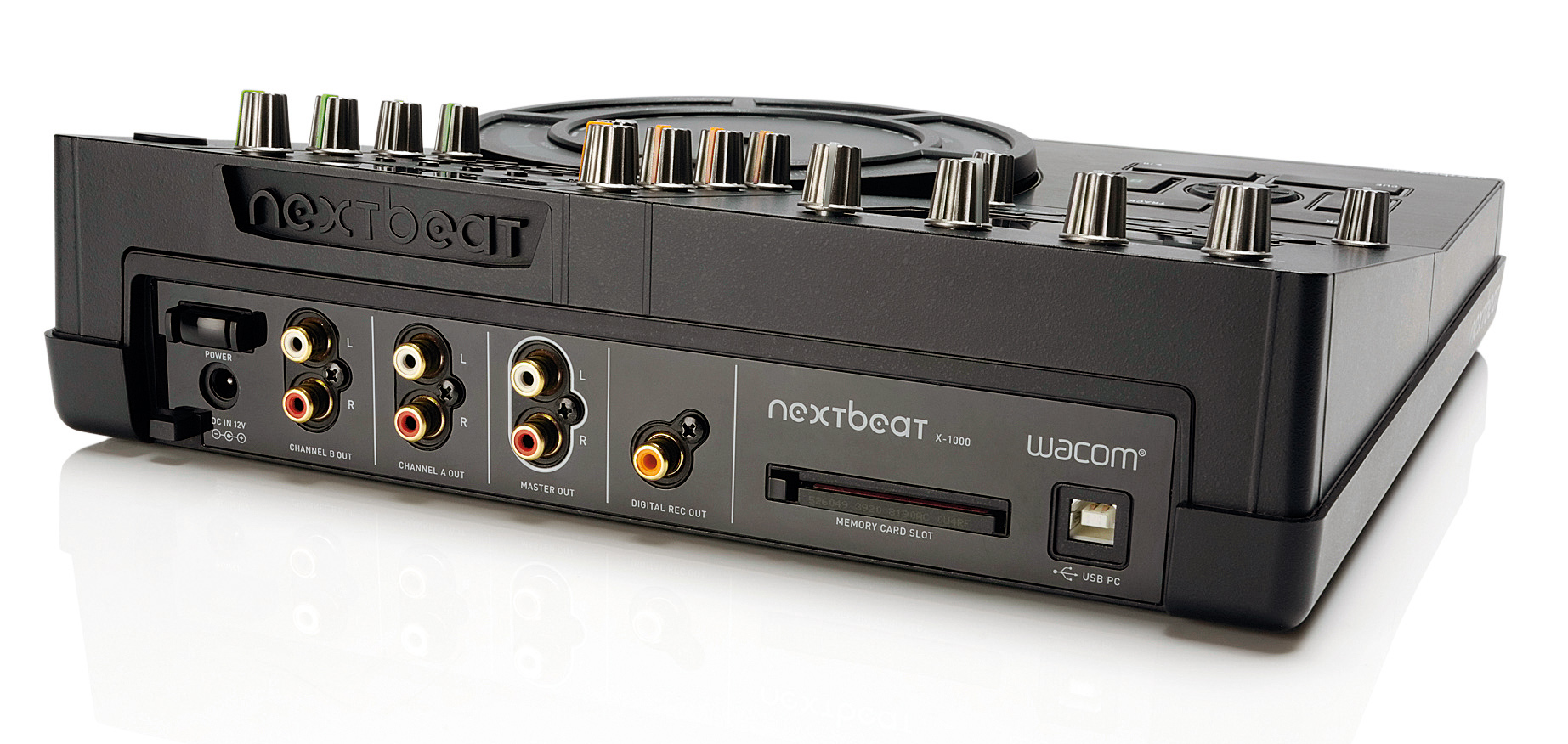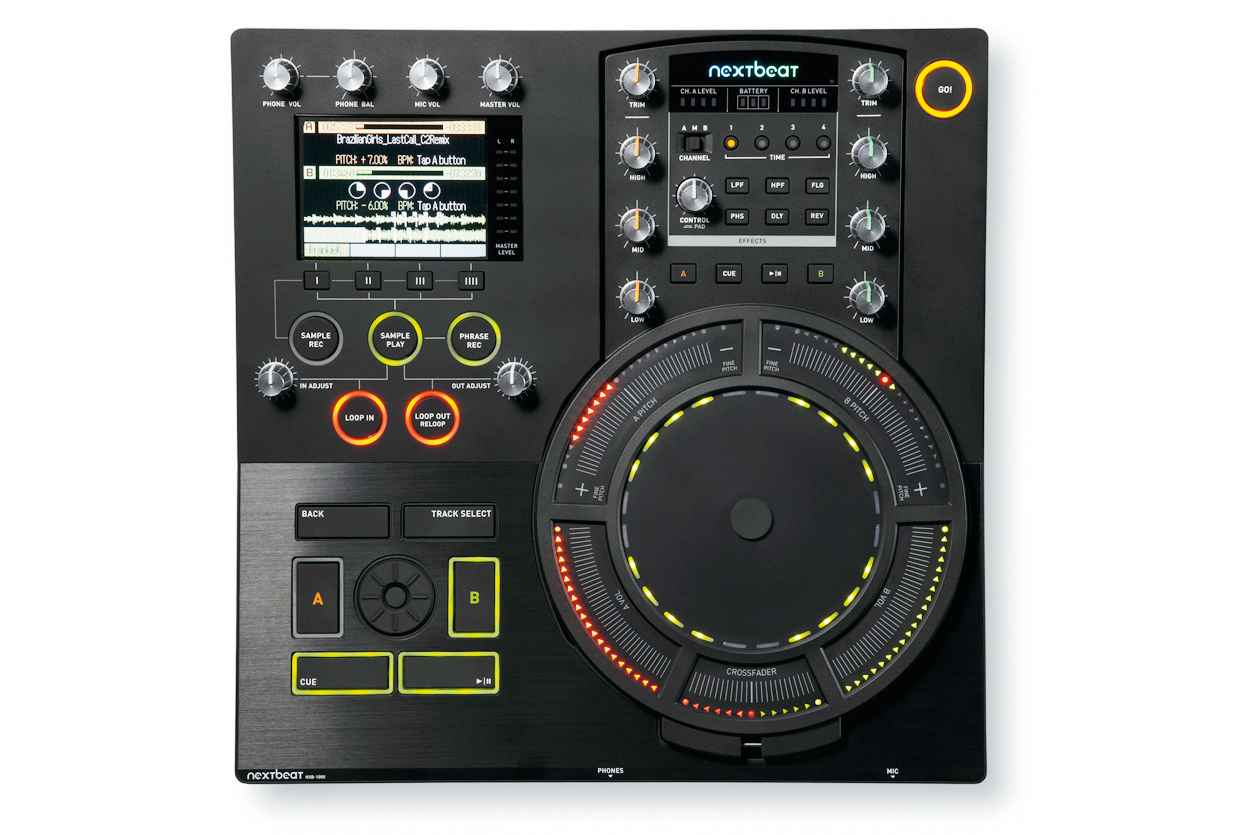MusicRadar Verdict
The Nextbeat delivers all it set out to, but the price and lack of auto features will put off a lot of people.
Pros
- +
Great built-in effects. Clever touch-platter control for scratching and pitch-shifting. Very simple to learn.
Cons
- -
No music analysis, quantising or syncing.
MusicRadar's got your back
The Wacom Nextbeat comprises two decks, a mixer, an effects section and sampler/phrase recorder in a unit that's the size of about a dozen vinyls. It certainly looks the part.
When un-boxing the device it looks and feels very sturdy, being light enough to transport around but with enough weight to give you a sense of reliability and rigidity. This from a device by Wacom, a company better known for its creative solutions - stylus touch tablets in the graphic design arena - than DJ or even audio gear. Nice work.
In detail
Powering up the unit displays the colour screen and puts you into track selection mode where a small jog wheel lets you navigate your tracks. Storage of tracks is handled via Compact Flash and the USB port on the rear of the unit enables the Nextbeat to become a simple drag and drop Compact Flash reader, but it doesn't read any sticks or drives.
So, no software is required for the Nextbeat as you simply navigate folders with the device. It supports WAV, AIFF, MP3 and AAC files with a maximum of 9,999 tracks and 1,000 folders on a single Compact Flash card. A 2GB card is included.
Aside from the Nextbeat being an all-in-one DJ solution, Wacom is pinning its hopes on a feature that you'll either love or hate - the pop out wireless controller, with the whole central section being removable. This seems a little gimmicky, especially when you realise that the way to release the controller is by pressing the Go! button, but it does work very well and is certainly different.
Nearly everything can be controlled via the removable controller including sample playback, effects and EQ. But, you'll need a set of wireless headphones if you're looking to cue up the next track while hot-footing it around the dancefloor.
"Wacom is pinning its hopes on a feature that you'll either love or hate - the pop out wireless controller."
Want all the hottest music and gear news, reviews, deals, features and more, direct to your inbox? Sign up here.
The Nextbeat is a completely self-contained system, but unfortunately, because it doesn't use any software on your Mac or PC, it doesn't scan or organise your library. This also leads to the first negative comment about the Nextbeat: the lack of track quantising and automatic syncing, again possibly due to the lack of software analysis. Hopefully this can be updated via firmware.
Essentially, this means mixing is done in the 'classic' way, with you having to manually pitch tracks and sync them using the touch platter. This is not the end of the world, except mixing this way is much easier if you have a platter for each deck, rather than having to switch between deck A and deck B while tweaking.
The Nextbeat provides outputs for using either an external mixer (splitting deck A and B on separate RCA connectors) or a master RCA output. Mixing internally with the Nextbeat isn't much fun. The touch faders do work, but aside from basic fades, they aren't the best solution if you want to do quick cuts or chops and really take some getting used to.

The platter, on the other hand, works brilliantly with CD-style pitching on a soft touch and vinyl-scratching mode on a firmer touch. This may sound like an accident waiting to happen, but the sensitivity is customisable in the machine's preferences and once you find your setting, it works very nicely.
Another excellent feature is the control of loop points. Although it would have been nice for loops to be automatically quantised, the manual method of tapping in and out points before tweaking them using rotaries is fast and accurate.
Sampling and effects
Sampling is also easy to set up, with phrases being automatically cut into four sections and placed on the four quarters of the platter for gate style sample triggering. These automatic cuts can be tweaked easily using the two rotary controllers to move the sample start points of each quarter.
Samples can be stored in four banks and you can set four playing points for each bank. Using the phrase record function you can also record loops of these samples in a performance manner and layer them to create original phrases. The only limit to this is that sampling and phrase recording is assigned to either deck A or B, so only one track can be playing while sample playback occurs.
The effects section will be very familiar if you've ever used the mixer effects on the Pioneer DJMs. The usual suspects are present - Reverb, Delay, Phaser, Flanger, Low-pass filter and High-pass filter. The effects can be controlled in two ways, either via a simple wet/dry rotary or by pushing the rotary, using the jog wheel platter to attain different effects variations.

This is very simple, intuitive and a great way to control the effects, but yet again it's another shift-function for the rotary and you'll need to carefully manage control of whether you're mixing, playing back samples or triggering effects using the touch pad.
Summary
At over a thousand pounds, the Nextbeat is a serious investment, and we think Wacom is going to find it difficult to convince people to ditch their laptops without a track sync feature or quantised loops. That said, if you have the cash and want to extend your capabilities with a regular two CDJs and a mixer setup, then the Nextbeat is certainly fun and great for dropping samples into your set.
The BPM counter works fine, but until there's some firmware that analyses, syncs and quantises your tracks and loops, Wacom is going to find it hard to compete with the most recent CDJs and the ever-popular laptop and DJ controller.
Future Music is the number one magazine for today's producers. Packed with technique and technology we'll help you make great new music. All-access artist interviews, in-depth gear reviews, essential production tutorials and much more. Every marvellous monthly edition features reliable reviews of the latest and greatest hardware and software technology and techniques, unparalleled advice, in-depth interviews, sensational free samples and so much more to improve the experience and outcome of your music-making.

